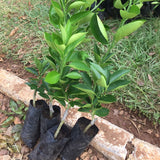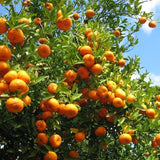Grafted. Starts fruiting after 2 years.
Common name: Orange.
Scientific name: Citrus sinensis.
English name: Navel oranges, sweet orange
Local name:
General information
Navel orange is not known anywhere as a wild plant but must have originated near the border between China and Vietnam. It is cultivated everywhere in the subtropics and tropics; roughly between latitudes 40° North and South and, near the equator, up to 2000 m altitude. Navel oranges are a seedless fruit, meaning they propagated from its cuttings.
The navel orange is an undeveloped fruit, which is why they come conjoined after blossoming. Depending on the region, they can be found blooming from winter through late spring. Navel oranges are known to blossom from the same tree. Farmers use the cuttings of the navel orange and periodically graft them into fresh stock. This helps to ensure they will be healthy and abundant.
Health benefits
Navel oranges are a great source of fiber, this help lower cholesterol which in turn controls diabetes. Navel oranges are high in potassium, this help the heart to decrease the risk of stroke, heart attack and other heart related diseases. The fruit also help to lower cholesterol and blood pressure, which is great to prevent heart problems.
Navel oranges contain high levels of vitamin C, this mineral is good for the skin because it protects it from skin damaged caused sun rays and pollution. The mineral also help to reduce wrinkles and improves skin texture.
Navel oranges are great sources of both Vitamin C and hesperidin. These two antioxidants are known to help prevent the formation of free radicals - which are known to cause cancer.






